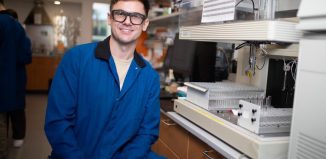Naturalist named Marine Sciences Center director
People travel to escape from their routines and desk jobs to the world where Christopher Paparo works. He routinely ventures in and around waters on the East End of Long Island that are filled with seal, dolphins, sharks, humpback whales and even an occasional octopus. The naturalist, who was a senior aquarist for the Long Island Aquarium for 13 years, recently got a new job: he is the director of the new $8.5 million Marine Sciences Center in Southampton.
“As a former Long Island University student, it’s amazing to see what’s transpired here,” said Paparo, who was just getting his feet wet in his new post. “What’s being built is amazing.”
The new center provides research facilities for graduate students, undergraduates and scientists, and will open officially in September. Notable guests at the grand opening are expected to include Stony Brook President Samuel Stanley, Senator Ken LaValle (R-Port Jefferson) and Assemblyman Fred Thiele (I-Sag Harbor). The 15,000-square-foot building is the latest resource for the School of Marine and Atmospheric Sciences.
“I’ll be wearing many, many hats,” said Paparo, who is known on the East End as a naturalist and the “Fish Guy” for wide-ranging photos of seals, sea lions, starfish and butterflies, among others, that make Long Island look like a “National Geographic” destination.
One of his first jobs is making sure the seawater system is up and running and maintained properly. He has to prepare tanks for researchers.
“A facility like this will allow us to grow and will make it a more attractive facility for researchers studying from other universities,” he said. “They can come here and work in a field station. It’s a world class facility to do their research.”
At the same time, he will help Lecturer Kurt Bretsch build out the “Semester at Sea” program, which is a three-year-old undergraduate effort. That program offers courses on Long Island marine habitats, which allows students to immerse themselves in the Shinnecock Bay, Atlantic Ocean and Great Peconic Bay. Another course emphasizes the maritime traditions of New York and New England.
Paparo can also accompany any group that needs a naturalist to explain what Long Island waters have and, if they decide to go on a boat ride, to show them what they’re seeing.
He said he’s “pretty flexible” about the kinds of tours he gives. For an ecology course, for example, he might take a group out to Shinnecock Bay, where he would compare the fish they catch by trawling over an eelgrass bed with those that live in a sandbar.
Classes have to pay a fee to cover the cost of the trip. Interested teachers or educators can contact SoMAS to ask about such trips.
The wet room at the Marine Sciences Center has a hallway of glass windows, which will allow visitors to watch researchers conduct their experiments on sea grass, shellfish and fish. The center will house modern molecular, remote detection and bioinformatic technology.
“My goal” as the first director of the new center “is to bring awareness to the community. Let them know what’s in their backyard,” said Paparo.
During trips into the water, he’s been surprised that people are so fascinated with sea horses. “Some people think they are mystical,” Paparo said. “We have a lot of them in the local bays.” Octopi, while not common, also live in the waters off Long Island.
Paparo and his wife Candy, the assistant director of animal training at the Long Island Aquarium, live in Calverton.
Everyone assumes, Paparo said, that animal training and working with marine mammals are glamorous jobs.
“Glamour is a small part of it. People don’t see the hours of cleaning, prepping and scrubbing. There’s a lot of work that goes into it for the 15-minute show.”
Paparo cautioned that those captive well-trained animals also can have a “bad day” and that all animals, even the cute, cuddly ones, can be dangerous.
Years ago, he responded to a call about a grey seal pup stranded on a beach. The woman who asked for help from the rescue program was getting too close. When he arrived and brought the seal back to the water, it bit him, growled and reacted the way he would have expected from an animal that felt threatened.
Still, he said working with and appreciating these animals and their environment is well worth the Friday night pipe fixes that keep the animals in his charge alive and the scars from difficult rescues.
“It’s awesome and very rewarding,” he said. “That’s what keeps us doing it.”
As a part of a monthly lecture series, Paparo is giving a free talk titled “Underwater Journey of Long Island Through the Eyes of a Fishing Biologist” at Duke Lecture Hall at 239 Montauk Highway in Southampton at 7:30 pm on Oct. 4.






